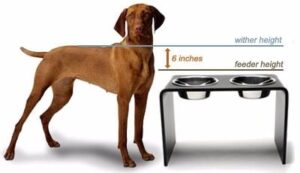Feeding your dog seems like a straightforward task—pour in the food, set down the bowl, and let them dig in. But have you ever thought about how the height of the dog bowl might be affecting your pup’s comfort, digestion, or even posture? It turns out that this seemingly minor detail can have a major impact on your dog’s well-being.
This complete guide covers expert tips, measurements, and benefits of elevated How High Should a Dog Bowl to help improve your pet’s comfort, posture, and digestion. From expert-backed data to real-world advice, you’ll gain valuable insights to help your dog eat more comfortably and healthily.
What’s the Right Height for Your Dog’s Bowl? The best height for your dog’s bowl is about level with their chest when they’re standing. This way, your dog can eat and drink without having to stretch their neck down or hunch over. It’s all about comfort! For bigger dogs, using a raised bowl can make a big difference—it helps reduce neck strain and can even support better digestion.
Why Bowl Height Matters for Dogs

Proper bowl height is about more than just convenience. It directly affects your dog’s:
- Posture and spinal alignment
- Digestive efficiency
- Joint comfort
- Reduced strain on neck, hips, and shoulders
- Cleanliness and food containment
Common Problems with Incorrect Bowl Height
- Too low: Can cause older dogs or large breeds to hunch uncomfortably.
- Too high: May cause small dogs to overreach, potentially leading to bloating or air intake.
Factors That Influence the Ideal Dog Bowl Height
1. Dog’s Size and Breed

Each breed comes with unique anatomical needs. For example:
- Small Breeds (e.g., Pomeranians, Chihuahuas): Typically do best with bowls on the ground or slightly elevated (2–4 inches).
- Medium Breeds (e.g., Cocker Spaniels, Border Collies): Benefit from bowls raised 6–10 inches.
- Large Breeds (e.g., Golden Retrievers, Labs): Often need bowl heights between 10–16 inches.
- Giant Breeds (e.g., Great Danes, Mastiffs): May require elevated bowls up to 18–20 inches.
2. Age and Mobility

Older dogs or those with arthritis may struggle to bend down. An elevated bowl relieves stress on joints and muscles.
3. Health Conditions

Dogs with the following issues may benefit from a specific bowl height:
- Megaesophagus: Elevated feeders help food move down the esophagus more easily.
- Arthritis or Hip Dysplasia: Reduces strain on hips and neck.
- Post-surgery recovery: Allows a more natural posture during eating.
- Pro Tip: Always consult your veterinarian if your dog has a medical condition that affects feeding.
4. Eating Habits

Some dogs are fast eaters and can benefit from slow feeder bowls that are also elevated to the correct height. This combination reduces the risk of bloat or gastric dilatation-volvulus (GDV), especially in deep-chested breeds.
How to Measure the Right Dog Bowl Height
Here’s a simple step-by-step method to determine your dog’s ideal bowl height:
-
Measure from the ground to your dog’s chest.
-
Subtract 3–6 inches depending on their size and comfort level.
- For large dogs: subtract 6 inches.
- For small dogs: subtract closer to 3 inches.
| Dog Height at Withers | Recommended Bowl Height |
|---|---|
| Under 12″ | 2–4 inches |
| 12–18″ | 6–10 inches |
| 19–24″ | 10–16 inches |
| 25″ and above | 16–20 inches |
Additional Tips:
- Test with adjustable stands before committing.
- Observe your dog’s posture while eating – their neck should be level, not bent up or down.
- Ensure your dog is not gulping food due to bowl positioning.
Elevated Dog Bowls: Pros and Cons
✅ Pros
- Easier access for senior dogs
- Improved posture and comfort
- Cleaner feeding area (less mess on the floor)
- Helpful for dogs with orthopedic or neuromuscular conditions
❌ Cons
- Elevated bowls may increase bloat risk in some large, deep-chested breeds (research is inconclusive).
- Some dogs might prefer bowls on the floor depending on their behavior or routine.
Note: The American Kennel Club (AKC) recommends discussing elevated bowls with your vet, especially for breeds prone to bloat.
Special Considerations for Puppies
Puppies grow fast, which means you’ll likely need to adjust bowl height regularly. Choose adjustable feeders or use stackable options so the bowl can “grow” with your pup.
Feeding Tips for Puppies:
- Keep bowl at a comfortable height to avoid strain.
- Avoid bowls that are too large or too deep.
- Monitor changes in their posture as they grow.
Choosing the Right Elevated Feeder
When shopping for elevated feeders, look for:
- Sturdy design: Prevent tipping or sliding
- Non-slip base: Ideal for eager eaters
- Material: Stainless steel is hygienic and dishwasher-safe
- Adjustability: Great for multi-dog households or growing pets
Real-World Case Example
Case Study: Bella the Boxer
Bella, a 7-year-old Boxer, was diagnosed with early arthritis. Her owners noticed she often struggled to eat from her floor-level bowl. After raising her bowl to 12 inches, Bella’s posture improved, she ate more slowly, and her limp diminished within a few weeks.
- Takeaway: Sometimes, a small adjustment in bowl height can make a huge difference in your dog’s quality of life.
Visual Aids and Infographics
To make this information more accessible, consider including:
- An illustrated measurement guide for bowl height
- A comparison chart of dog sizes and ideal bowl elevations
- A before-and-after posture diagram for bowl height effects
-
Alt Text Example for Image: “Chart showing ideal dog bowl height based on breed and chest height.”
Conclusion
Choosing the correct dog bowl height isn’t just about looks or convenience—it’s a decision that can impact your dog’s digestion, posture, and long-term health. By considering your dog’s breed, size, age, and any medical needs, you can select the ideal setup that encourages healthy eating habits and a happier pup.
Ready to upgrade How High Should a Dog Bowl Be? Measure your pet today and consider an elevated feeder that supports their needs.

